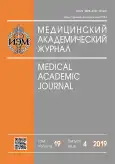Antidepressant-like action of hypoxic postconditioning is accompanied by the up-regulation of hippocampal HIF-1α and erythropoietin
- Authors: Zenko M.Y.1, Rybnikova E.A.1
-
Affiliations:
- Pavlov Institute of Physiology RAS
- Issue: Vol 19, No 4 (2019)
- Pages: 41-46
- Section: Original research
- Published: 03.04.2020
- URL: https://journals.eco-vector.com/MAJ/article/view/19075
- DOI: https://doi.org/10.17816/MAJ19075
- ID: 19075
Cite item
Abstract
Objective. The aim of the study was to reveal the role of HIF-1α in the effects of hypoxic postconditioning in the rat experimental model of depression “learned helplessness”.
Materials and methods. The studies were performed in the “learned helplessness” paradigm which represents a reliable experimental model of depression in rats. The development of the pathology was evaluated in the behavioral open field test and by the baseline level of plasma corticosterone. Correction of behavioral deficit was performed by three episodes of hypoxic postconditioning (360 mmHg, 2 h). Changes in the immunopositivity of HIF-1α and erythropoietin in the hippocampus of rats were evaluated. An inhibitor of HIF-1α subunit translation topotecan (1 mg/kg, i.p., Santa Cruz, USA) was used on the 4th day after the footshock stress. On the 9th day, animals were tested in the open field test to assess the level of depressive-like behavior.
Results. It was shown that postconditioning by three episodes of mild hypobaric hypoxia resulted in the correction of behavioral deficit produced by the “learned helplessness” aversive stress, and the levels of corticosterone did not differ from the baseline in these animals. These behavioral and hormonal effects were accompanied by the increased level of immunopositive HIF-1α and its transcriptional downstream target erythropoietin in the dorsal and ventral hippocampus. Using of HIF-1 inhibitor topotecan dramatically worsen the severity of the depressive-like symptoms.
Conclusion. The findings suggest that HIF-1 appears to have the antidepressant-like activities and that hypoxic postconditioning-induced stimulation of HIF-1α and erythropoietin level might contribute to the endogenous mechanisms which compensate for the pathogenic effects of stressors, particularly for the development of stress-induced depression.
Full Text
About the authors
Mikhail Yu. Zenko
Pavlov Institute of Physiology RAS
Author for correspondence.
Email: ZenkoMY@infran.ru
ORCID iD: 0000-0002-9868-0598
SPIN-code: 6632-3116
Lab. of Regulation of Brain Neuron Functions
Russian Federation, Saint PetersburgElena A. Rybnikova
Pavlov Institute of Physiology RAS
Email: RybnikovaEA@infran.ru
ORCID iD: 0000-0002-8956-726X
SPIN-code: 9663-4704
Lab. of Regulation of Brain Neuron Functions
Russian Federation, Saint PetersburgReferences
- Samoilov MO, Rybnikova EA, Tulkova EI, et al. Hypobaric hypoxia affects rat behavior and immediate early gene expression in the brain: the corrective effect of preconditioning. Dokl Biol Sci. 2001;381:513-515. https://doi.org/10.1023/a:1013301816108.
- Patent RUS No. 2437164/ 20.12.2011. Rybnikova EA, Samoilov MO. Sposob reabilitatsii posle gipoksii, vyzyvayushchey narusheniya funktsiy mozga v modelyakh na laboratornykh zhivotnykh.
- Rybnikova E, Vorobyev M, Pivina S, Samoilov M. Postconditioning by mild hypoxic exposures reduces rat brain injury caused by severe hypoxia. Neurosci Lett. 2012;513(1):100-105. https://doi.org/10.1016/j.neulet.2012.02.019.
- Gamdzyk M, Makarewicz D, Slomka M, et al. Hypobaric hypoxia postconditioning reduces brain damage and improves antioxidative defense in the model of birth asphyxia in 7-day-old rats. Neurochem Res. 2014;39(1):68-75. https://doi.org/10.1007/s11064-013-1191-0.
- Vetrovoi OV, Rybnikova EA, Glushchenko TS, Samoilov MO. Effects of hypoxic postconditioning on the expression of antiapoptotic protein Bcl-2 and neurotrophin BDNF in hippocampal field CA1 in rats subjected to severe hypoxia. Neurosci Behav Physiol. 2015;45(4):367-370. https://doi.org/10.1007/s11055-015-0083-y
- Vetrovoy OV, Rybnikova EA, Glushchenko TS, et al. Mild hypobaric hypoxic postconditioning increases the expression of HIF-1α and erythropoietin in the CA1 field of the hippocampus of rats that survive after severe hypoxia. Neurochem J. 2014;8(2):103-108. https://doi.org/10.1134/s1819712414020123.
- Sarieva KV, Lyanguzov AY, Galkina OV, Vetrovoy OV. The effect of severe hypoxia on HIF1- and Nrf2-Mediated mechanisms of antioxidant defense in the rat neocortex. Neurochem J. 2019;13(2):145-155. https://doi.org/10.1134/s1819712419020107.
- Kodama T, Shimizu N, Yoshikawa N, et al. Role of the glucocorticoid receptor for regulation of hypoxia-dependent gene expression. J Biol Chem. 2003;278(35):33384-33391. https://doi.org/10.1074/jbc.M302581200.
- Jelkmann W. Molecular Biology of Erythropoietin. Intern Med. 2004;43(8):649-659. https://doi.org/10.2169/internalmedicine.43.649
- Marti HH. Erythropoietin and the hypoxic brain. J Exp Biol. 2004;207(18):3233-3242. https://doi.org/10.1242/jeb.01049.
- Paschos N, Lykissas MG, Beris AE. The role of erythropoietin as an inhibitor of tissue ischemia. Int J Biol Sci. 2008;4(3):161-168. https://doi.org/10.7150/ijbs.4.161.
- Tringali G, Pozzoli G, Lisi L, Navarra P. Erythropoietin inhibits basal and stimulated corticotropin-releasing hormone release from the rat hypothalamus via a nontranscriptional mechanism. Endocrinology. 2007;148(10):4711-4715. https://doi.org/10.1210/en.2007-0431.
- Seligman ME, Beagley G. Learned helplessness in the rat. J Comp Physiol Psychol. 1975;88(2):534-541. https://doi.org/10.1037/h0076430.
- Rybnikova E, Mironova V, Pivina S, et al. Involvement of the hypothalamic-pituitary-adrenal axis in the antidepressant-like effects of mild hypoxic preconditioning in rats. Psychoneuroendocrinology. 2007;32(7):813-823. https://doi.org/10.1016/j.psyneuen.2007.05.010.
- Hall CS. Emotional behavior in the rat. III. The relationship between emotionality and ambulatory activity. J Comp Psychol. 1936;22(3):345-352. https://doi.org/10.1037/h0059253.
- Kaelin WG, Ratcliffe PJ. Oxygen sensing by metazoans: the central role of the HIF hydroxylase pathway. Mol Cell. 2008;30(4):393-402. https://doi.org/10.1016/j.molcel.2008. 04.009.
- Agani F, Jiang B-H. Oxygen-independent regulation of HIF-1: novel involvement of PI3K/ AKT/mTOR pathway in cancer. Curr Cancer Drug Targets. 2013;13(3):245-251. https://doi.org/10.2174/1568009611313030003.
- O’Rourke JF, Tian Y-M, Ratcliffe PJ, Pugh CW. Oxygen-regulated and transactivating domains in endothelial PAS Protein 1: comparison with hypoxia-inducible factor-1α. J Biol Chem. 1999;274(4):2060-2071. https://doi.org/10.1074/jbc.274.4.2060.
- Masson N, Willam C, Maxwell PH, et al. Independent function of two destruction domains in hypoxia-inducible factor-alpha chains activated by prolyl hydroxylation. EMBO J. 2001;20(18):5197-5206. https://doi.org/10.1093/emboj/ 20.18.5197.
- Jegalian AG, Wu H. Differential roles of SOCS family members in EpoR signal transduction. J Interferon Cytokine Res. 2002;22(8):853-860. https://doi.org/10.1089/ 107999002760274863.
- Risau W. Mechanisms of angiogenesis. Nature. 1997;386(6626):671-674. https://doi.org/10.1038/386671a0.
- Rybnikova EA, Baranova KA, Gluschenko TS, et al. Role of HIF-1 in neuronal mechanisms of adaptation to psychoemotional and hypoxic stress. International Journal of Physiology and Pathophysiology. 2015;6(1):1-11. https://doi.org/10.1615/IntJPhysPathophys.v6.i1.10.
- Baranova KA, Rybnikova EA, Samoilov MO. The dynamics of HIF-1α expression in the rat brain at different stages of experimental posttraumatic stress disorder and its correction with moderate hypoxia. Neurochemical Journal. 2017;11(2): 149-156. https://doi.org/10.1134/s1819712417020027.
- Lee HY, Gao X, Barrasa MI, et al. PPAR-alpha and glucocorticoid receptor synergize to promote erythroid progenitor self-renewal. Nature. 2015;522(7557):474-477. https://doi.org/10.1038/nature14326.
Supplementary files










